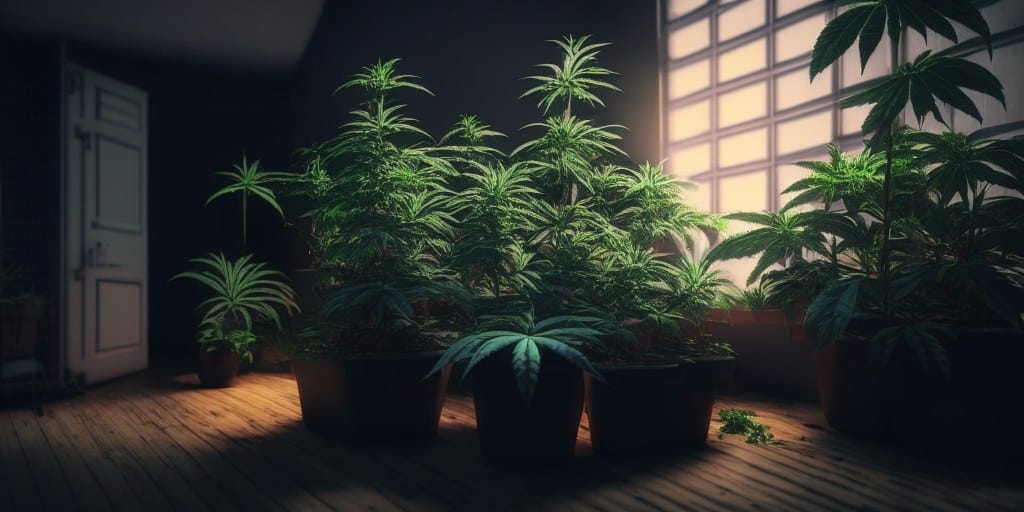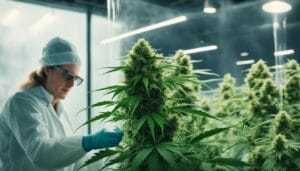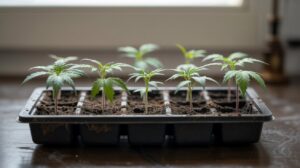Tips for Growing Cannabis at Home Safely & Easily

As the popularity of cannabis continues to bloom, enthusiasts are seeking cannabis-growing advice to transform their passion into thriving indoor gardens. With our expert tips for growing cannabis at home, you’re poised to cultivate your green thumb within the comfort of your own space. Prioritizing safety and simplicity, we’ll navigate through indoor cannabis cultivation procedures that ensure both peace of mind and plant vitality.
Key Takeaways
- Create a dedicated and controlled grow space for maximum safety
- Equip your space with a dehumidifier to prevent mold in high humidity
- Invest in safety-compliant electrical installations to minimize fire risk
- Follow local guidelines for the safe disposal of plant waste
- Use protective gear to reduce UV exposure while tending to your plants
- Stay informed on local laws for legal and responsible cultivation
Understanding Legal Considerations for Home Cannabis Cultivation
For those embarking on the journey of home cannabis cultivation, it’s essential to navigate the complex tapestry of laws that bind this practice. Whether you’re consulting a beginner’s guide to growing cannabis or are furthering your green thumb skills, understanding legal considerations for growing cannabis is imperative to ensure you’re growing responsibly and legally.
Every cannabis enthusiast needs to be vigilant about the state-specific legislation that dictates what is permissible within their residence. Country-wide regulations can vary significantly, with states like Colorado embracing cultivation, while others like Idaho enforce stringent prohibitions. Below is a comparative overview of different regions and their legal stance on cannabis cultivation at home:
| Region | Number of Plants Allowed | Regulatory Notes |
|---|---|---|
| Canada | Up to 4 plants per household | Restrictions on visibility from public spaces; plants must not be accessible to minors. |
| California | Up to 6 plants per household | Local ordinances may impose additional restrictions. |
| Virginia | Up to 4 plants per household | Labeling required with contact information and notice that plants are for personal use. |
| North Carolina | None | Home cultivation is illegal under current laws. |
Remember, statutes can evolve, and what might be a no-go zone today could very well transform into a green-light district tomorrow. Given the dynamic nature of cannabis laws, arming oneself with current information is your finest defense against inadvertent legal infractions. Signing up for state or local newsletters, joining related community groups, or regularly checking government websites can be smart moves for the prudent cultivator.
Consider consulting with legal professionals who specialize in cannabis law, which can provide an extra layer of certainty. While the thrill of growing cannabis is undeniable, ensuring your efforts align with the law is the bedrock of a sustainable, stress-free cultivation experience.
Preparing Your Grow Space for Safety and Efficiency
Creating an ideal growing environment for cannabis starts with meticulous planning and attention to detail. Providing optimal growing conditions begins with establishing a safe and efficient grow space. Let’s walk through the essentials of setting up a space that accommodates the needs of your cannabis plants while prioritizing safety.
Choosing the Right Location
When planning how to grow cannabis at home, the importance of selecting the right location cannot be overstated. It’s vital to pick a space that is both secure and stable in terms of environmental conditions. To ensure the safety of your household and your plants, select a location that is out of reach for children and pets to circumvent accidental poisoning. Moreover, the ideal grow room should have non-porous walls to prevent unwanted moisture accumulation, which greatly reduces the risk of mold formation.
Ensuring Proper Ventilation
One of the most essential equipment for growing cannabis effectively is a robust ventilation system. Proper air circulation is a cornerstone for maintaining the health of your plants. It regulates the temperature, curbs humidity levels, and replenishes carbon dioxide. Adequate ventilation is essential for safeguarding against potential air quality issues that might arise from cultivating plants indoors, especially when the natural airflow is restricted.
Selecting Appropriate Containers and Soil
For successful cannabis cultivation, one cannot overlook the significance of the right containers and soil. It’s not just about how to grow cannabis at home; it’s about growing it efficiently. Young seedlings thrive in smaller containers with sufficient drainage, which can later be transplanted into larger pots to accommodate root growth. Accompanying these containers with high-quality soil rich in nutrients will set the foundation for robust plant growth while ensuring optimal moisture management.
The following table outlines essential considerations when preparing your grow space:
| Aspect | Importance | Recommendations |
|---|---|---|
| Location | Safety, Accessibility, Environmental Stability | Choose a secure area; Use non-porous materials to inhibit mold growth. |
| Ventilation | Air Quality, Temperature, Humidity Control | Install adequate ventilation systems; Regular maintenance checks. |
| Containers & Soil | Plant Health, Growth Support, Moisture Management | Use containers with drainage; Opt for nutrient-rich soil. |
By integrating these cannabis growing tips and best practices into your routine, you’re on the path to cultivating cannabis at home that not only flourishes but does so in a manner that’s congruent with your safety standards. Remember, preparation is key to reaping the rewards of your green-thumb efforts.
How To Grow Cannabis at Home
Embarking on the journey of indoor cannabis cultivation starts with a foolproof step-by-step guide for growing cannabis at home. Mastering the essentials can lead to rewarding harvests from your homegrown cannabis plants. Here’s how to lay down the groundwork.
- Seed Germination: Kickstart your plants’ life by germinating the seeds in a warm, moist environment. Typically, seeds should sprout in a few days.
- Planting: After successful germination, transfer your young seedlings into high-quality soil, taking care not to damage the delicate roots.
- Lighting: Cannabis plants require plenty of light to grow. Utilize a regimen that mimics the sun’s natural cycle, usually 18 hours of light to 6 hours of darkness for the vegetative growth stage.
- Watering Balance: Maintaining the right watering schedule is crucial—too much can lead to root rot, and too little can stunt growth.
- Temperature Regulation: Manage your grow room’s climate to remain within 70 to 85°F (21 to 29°C) for optimal growth.
These fundamental practices will guide your cannabis plants through their vegetative stage. With attention, care, and the right conditions, you will set the stage for a flourishing flowering phase, culminating in a bounty of buds.

Creating the Ideal Lighting and Environment for Your Cannabis Plants
The journey to maximizing cannabis yield at home begins with establishing optimal growing conditions. How you light and climate-control your space is critical in cultivating lush, healthy cannabis plants. The choice of lighting and the control of environmental factors lay the groundwork for success in your home grow operation.
Opting for LED Growth Lights
For home growers striving to create optimal growing conditions for cannabis, LED grow lights stand out as a superior choice. Their energy efficiency is a boon for both the environment and your electricity bills, and they produce significantly less heat than HID or fluorescent options. LEDs shine brightly in the cannabis culture, supporting plants from seedling to flowering with an array of light spectrums tailored for each growth stage. This essential equipment for growing cannabis can help you avoid the common errors of under or over-lighting, both of which can compromise plant health and yield.
Maintaining Humidity and Temperature
A crucial aspect of how to grow cannabis at home is the mastery of humidity and temperature control. Cannabis plants thrive within a certain humidity range, and maintaining this balance helps prevent the onset of mold and other diseases. A high-quality dehumidifier is more than an accessory; it’s an integral piece of machinery in your quest for cultivar excellence. Pairing a hygrometer with your dehumidifier lets you monitor your environment with precision, making adjustments as needed to sustain that perfect ambient moisture level. Similarly, temperature control is a non-negotiable in the home grower’s checklist. Adequate ventilation and temperature regulation work in concert to engender an atmosphere where your cannabis plants can truly flourish.
Providing Essential Nutrients and Water
To achieve maximizing cannabis yield at home, it is essential to understand the nutritional needs of your cannabis plants throughout their life cycle. Initially, cannabis plants require soil that is rich in nutrients. As they progress into the flowering stage, the addition of bloom fertilizers can significantly aid in the development of robust and potent buds.
Watering practices play an equally important role in best practices for growing cannabis. Consistent and proper watering is critical to prevent both overwatering, which can lead to root rot, and under-watering, which can stress plants and reduce yields. Uncover a balance between too much and too little to ensure your cannabis plants flourish.
| Nutrient Phase | Essential Nutrients | Watering Best Practices |
|---|---|---|
| Vegetative | Nitrogen-rich fertilizers for growth | Moist soil, avoid over-saturating |
| Pre-flowering | Balanced NPK fertilizers to transition | Reduce frequency, increase quantity per watering |
| Flowering | Phosphorous and potassium for bud development | Water when topsoil feels dry to maintain optimal moisture |
Maximizing cannabis yield at home is not only about the number of plants you grow, but also about the quality of care they receive throughout their development. By following best practices for growing cannabis, which includes providing the right nutrients and water, you create the ideal environment for your plants to produce the best possible yield.
Maximizing Cannabis Yield at Home with Expert Techniques
For those exploring indoor cannabis cultivation, the quest for maximizing cannabis yield at home is a journey of learning and applying expert techniques. This section provides a clear, step-by-step guide for growing cannabis at home, designed to help you reap the best harvest from your grow space.
Training Techniques for Increased Yield
Applying the right training techniques can greatly enhance your cannabis plants’ performance. These methods not only optimize available space but also expose more of the plant to light, leading to better growth and subsequently, larger yields. Let’s delve into some effective approaches:
- Low-Stress Training (LST): This involves gently bending and tying the plant’s branches, which helps the plant to grow horizontally and creates an even canopy for a more uniform light distribution.
- High-Stress Training (HST): Techniques such as topping or supercropping are more aggressive but can lead to a significant increase in the number of budding sites.
- Screen of Green (ScrOG): Using a screen to train your plants can maximize light exposure and encourage the growth of multiple colas, rather than just one main stem.
Optimizing Harvest Times
Timing your harvest can be the difference between good and great cannabis. To ensure you’re maximizing the yield at home, observe your plants closely as harvest time approaches. The following table illustrates the signs that your cannabis is ready to be harvested:
| Harvest Sign | Description |
|---|---|
| Pistil Maturity | Look for pistils that are darkening and curling inwards – a clear sign of maturity. |
| Trichome Clarity | Trichomes that are milky white or amber indicate peak THC levels and readiness for harvest. |
| Leaf Color | When larger leaves turn yellow and the overall foliage begins to fade, it’s a sign that the plant has utilized most of its nutrients and is ready for harvest. |
Adhering to a meticulous step-by-step guide for growing cannabis at home and being patient with your plants can ensure you’re not just growing cannabis, but cultivating top-quality yields that are the envy of other growers.
Embracing Organic Cannabis Cultivation
As the interest in how to grow cannabis at home surges, so does the appeal of organic cannabis cultivation. By adopting organic methods, cultivators ensure that they produce a healthier and more environmentally friendly crop. It’s about going beyond yield and potency, focusing on the quality and purity of the final product. In this section, we delve into why incorporating organic soil mixes and employing pesticide-free pest management can enhance your home cannabis cultivation experience.
Organic Soil Mixes and Nutrients
Choosing the right foundation for your cannabis plants is paramount. Organic soil, rich with natural nutrients, provides a living ecosystem for your plants. This type of soil promotes strong root development and offers a buffering capacity to keep pH levels stable. When using essential equipment for growing cannabis, consider organic nutrients that can be slowly released into the soil, mimicking the plant’s natural growing conditions.
Pesticide-Free Pest Management
Integral to the philosophy of organic cannabis cultivation is forgoing synthetic pesticides in favor of natural pest deterrents. Beneficial insects, companion planting, and physical barriers can all serve as effective means to protect your crop without compromising its organic integrity. By relying on these strategies, home growers can maintain a clean grow space that supports the viability and organic nature of their cannabis plants.
Essential Equipment for Growing Cannabis and Ensuring Safety
Embarking on the journey of indoor cannabis cultivation requires not only a green thumb but also a focus on fostering a safe environment. To achieve this, one must prioritize assembling the essential equipment for growing cannabis, embracing both the tools for growth and measures for safety. High-caliber grow lights are a cornerstone, with low-power LED options reigning supreme for their energy efficiency and reduced heat output. Yet, the array does not end here; proper airflow is ensured by advanced ventilation systems, a critical component to maintaining the delicate balance of temperature and humidity that cannabis plants thrive in.
Moreover, safety transcends beyond mere compliance. Integrating carbon monoxide detectors within your sanctuary of growth not only secures your space but also epitomizes adherence to best practices for growing cannabis. Don protective gear to shield yourself from potential hazards like UV radiation and minimize contact with any chemical agents used during cultivation. It’s these layers of defense that help cultivate not only healthy plants, but also a secure and thriving home environment.
From the precision of automated watering systems to the regulation of grow room climates, the array of equipment deployed plays a pivotal role in both boosting yields and safeguarding the grower. For installations that seem daunting, do not shy away from seeking professional assistance, ensuring that your system operates impeccably and aligns with all safety regulations. In the diligent application of proper equipment and safety protocols lies the harvest of your success. Nurture your cultivation space with attention to detail, and reap the rewards of a bountiful, secure cannabis grow operation.
FAQ
What are the first steps to safely grow cannabis at home?
The first steps include understanding your local laws regarding cannabis cultivation, selecting a secure and appropriate space for growing, ensuring the space has proper ventilation, light, and temperature control, and investing in essential equipment such as quality soil, containers with drainage, grow lights, and safety devices like carbon monoxide detectors.
What legal considerations should I be aware of before starting home cannabis cultivation?
It’s imperative to know the legal framework specific to your area, as some places allow limited home cultivation while others have strict prohibitions. Always stay current with any changes in legislation and ensure your setup complies with local guidelines and restrictions.
How should I prepare my grow space for safety and efficiency?
Choose a location that can be easily cleaned, has minimal moisture absorption to prevent mold, and is inaccessible to pets and children. Incorporate an effective ventilation system, proper containers, and high-quality soil, and ensure that all electrical installations adhere to safety regulations.
Can you provide a step-by-step guide for growing cannabis at home?
The basic steps include germinating the seeds, transplanting the sprouted seedlings to containers with high-quality soil, maintaining a controlled environment with optimal lighting, watering, and temperature, and then moving through the vegetative and flowering stages with appropriate nutrient additions until it’s time to harvest.
What lighting should I use for indoor cannabis cultivation?
LED grow lights are highly recommended due to their energy efficiency, lower heat emissions, and suitability for all stages of plant growth.
How do I maintain the proper humidity and temperature for growing cannabis?
Use a dehumidifier to manage moisture levels and prevent mold and plant diseases. Keep the grow space temperature between 70-85°F (21-29°C) during the day and slightly cooler at night to mimic natural conditions.
What are essential nutrients and watering practices for cannabis?
Cannabis plants require balanced nutrients, typically more nitrogen during vegetative growth and more phosphorus and potassium during flowering. Water plants when the top inch of soil is dry to the touch, and ensure proper drainage to avoid overwatering.
How can I maximize my cannabis yield at home?
Implement training techniques such as topping or low-stress training to increase light exposure and airflow to the plants, manage vegetative growth carefully for optimal size, and ensure a uniform canopy for even light distribution, leading to increased yields.
What signs indicate it’s time to harvest my cannabis plants?
Look for the darkening and curling of piston hairs, the swelling of the resin glands (trichomes), and the yellowing of fan leaves. Using a magnifying glass, check if the trichomes have gone from clear to a milky white or amber color to determine the ideal harvest time.
Why should I consider organic cannabis cultivation and how can I achieve it?
Organic cultivation can lead to a purer and potentially more flavorful product. Use organic soil mixes, avoid chemical fertilizers, and pesticides, and consider using organic compost teas and natural pest control methods.
What pesticide-free pest management strategies can I use?
Employ biological controls such as beneficial insects, use physical barriers like screens or sticky traps, and practice good hygiene to prevent infestations. If necessary, use organic, non-toxic pesticides as directed.
What essential equipment do I need to grow cannabis safely indoors?
Key equipment includes grow lights, a ventilation system, a dehumidifier, a reliable temperature control system, safe electrical installations, containers, high-quality soil, nutrient solutions, and safety gear such as goggles and gloves to protect you while handling plants and equipment.
Suggested Articles
;)
;)
;)




 18 Jul 2025
18 Jul 2025  17 min read
17 min read


 January 12, 2024
January 12, 2024 


RESPONSES (0)
No responses yet. Be the first to respond!